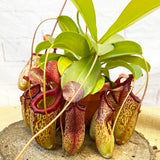New
100 - 120cm Spathiphyllum Peace Lilly 24cm Pot House Plant
The Spathiphyllum, commonly known as the Peace Lily, is a popular houseplant appreciated for its lush foliage and elegant white flowers. Here's a detailed guide on caring for this beautiful and air-purifying plant:
Description
- Appearance: Peace Lilies are characterized by their glossy, dark green leaves and white, spoon-shaped flowers that emerge from the plant's center. These flowers are actually a specialized leaf bract surrounding a spadix, which is a spike of minute flowers.
- Growth Habit: They have a clumping growth habit and can reach heights of up to 3 feet (about 1 meter) indoors. The leaves can grow quite large, making it an excellent plant for filling space.
- Flowering: They bloom primarily in the spring, but indoor plants can flower sporadically throughout the year.
Care Guide
-
Lighting: Peace Lilies prefer bright, indirect sunlight. Direct sunlight can scorch their leaves, while too little light may prevent them from flowering. A spot near a window with sheer curtains would be ideal.
-
Temperature: They thrive in temperatures between 18°C to 26°C. Avoid placing your Peace Lily in areas with sudden temperature changes or drafts.
-
Watering: Keep the soil consistently moist but not soggy. Water when the top inch of soil feels dry. They are sensitive to chlorine in tap water, so it's best to use filtered or distilled water. They also respond well to being watered from the bottom.
-
Soil: Use a well-draining, peat-based potting mix. Good drainage is essential to prevent root rot.
-
Humidity: Peace Lilies prefer high humidity. If your home is dry, you can increase humidity by placing the pot on a tray of wet pebbles, misting the leaves regularly, or using a humidifier.
-
Feeding: Feed every 6-8 weeks with a balanced, water-soluble fertilizer during the growing season (spring and summer). Reduce feeding in the fall and winter when growth slows down.
-
Pruning: Remove yellow or brown leaves at their base to keep the plant looking tidy. After a flower fades, cut the stem back near the base of the plant.
-
Repotting: Repot every 1-2 years, or when the plant becomes root-bound. Use a pot only one size larger than the current one to avoid overwatering issues.
-
Propagation: Propagate by dividing the plant during repotting.
Common Issues
- Brown Leaf Tips: This can be caused by over-fertilizing, low humidity, or fluoride in the water.
- Yellow Leaves: Overwatering is a common cause. Ensure proper drainage and don’t let the plant sit in water.
- Drooping: Often a sign of underwatering. Peace Lilies will perk up quickly once watered.
- Pests: They can be susceptible to common houseplant pests like aphids and mealybugs.
Peace Lilies are not only beautiful but also effective in purifying indoor air, filtering out harmful toxins. They are relatively easy to care for, making them an excellent choice for both novice and experienced plant enthusiasts. With the right conditions and care, your Peace Lily will thrive, bringing a touch of elegance and tranquility to your home.
Check out our YouTube video to see exactly how we pack for safe delivery.
- Plants are supplied in plastic nursery pots unless stated in the product title.
- Plants are not for consumption unless stated as edible.
- Plant heights can fluctuate +/- 10%.
- Our plants are kept at our tropical nursery in Yorkshire where we maintain an average temperature of 18c.






































